新闻中心 
数据分析笔试题系列(5)(数据分析考试题)
1、我们把用户对商品的评分用稀疏向量表示,保存在数据库表t里面: t的字段有:uid,goods_id,star; uid是用户id;goods_id是商品id;star是用户对该商品的评分,值为1-5。 现在我们想要计算向量两两之间的内积,内积在这里的语义为:对于不同的用户,如果他们都对同样的一批商品打了分,那么对于这里面的每个人的分数乘起来,并对这些乘积求和。比如g0:2*2+2*4+2*5+4*2+4*4+4*5+5*2+5*4+5*5=121
建表语句:
create table B(uid VARCHAR(12),good_id VARCHAR(12),star int(10)); INSERT INTO B (uid,good_id,star) VALUES(u0,g0,2),(u0,g1,3),(u1,g0,4),(u1,g1,3),(u2,g0,5),(u2,g1,1);表结构如下:
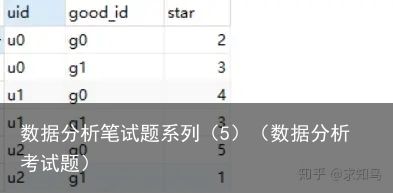 select t.good_id,sum(xiangchen)
from (
select t1.uid,t1.good_id,t1.star*t2.star as xiangchen --3*6
from (
select *
from B
)t1
inner join (
select *
from B
)t2
on t1.good_id=t2.good_id
)t
group by t.good_id;
select t.good_id,sum(xiangchen)
from (
select t1.uid,t1.good_id,t1.star*t2.star as xiangchen --3*6
from (
select *
from B
)t1
inner join (
select *
from B
)t2
on t1.good_id=t2.good_id
)t
group by t.good_id;
2、员工表,宿舍表,部门表,统计出宿舍楼各部门人数表
设员工表为employee,字段为id,employee_name,belong_dormitory_id,belong_department_id;
宿舍表为dormitory,字段为id,dormitory_number;
部门表为department,字段为id,department_name
思路:
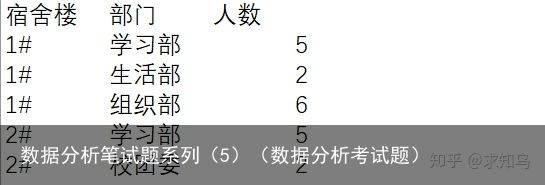 select t3.dormitory_name,t2.department_number,count(distinct t1.employee_name)
from (
select *
from employee
)t1
inner join (
select *
from department
)t2
on t1.belong_department_id=t2.id
inner join (
select *
from dormitory
)t3
on t3.id=t1.belong_dormitory_id
group by t3.dormitory_name,t2.department_number
select t3.dormitory_name,t2.department_number,count(distinct t1.employee_name)
from (
select *
from employee
)t1
inner join (
select *
from department
)t2
on t1.belong_department_id=t2.id
inner join (
select *
from dormitory
)t3
on t3.id=t1.belong_dormitory_id
group by t3.dormitory_name,t2.department_number3、给出一堆数和频数的表格,统计这一堆数中位数
设表table中字段为id,number,frequency
create table table_a (id VARCHAR(2),number int(12),frequency int(12)); insert into table_a values (b,2,4),(c,3,3),(d,4,5),(a,1,2); 建立表格时,注意将number,frequency的顺序打乱,以免出现歧义!
建立表格时,注意将number,frequency的顺序打乱,以免出现歧义!思路:
2+3+4+5)+1)/2=7.5;我们需要知道排序在第7,第8位的数字,然后求其平均数,即为需要求的中位数!
分两种情况考虑:
a:1,1,2,2的情况,中位数是1+2)/2=1.5
b:1,1,2,2,3的情况,中位数是2!
select (t1.number+lead(t1.number,1)over(order by t1.number))/2 from ( select number,frequency,sum(frequency) over( order by number) as ran from table_a )t1 inner join ( select floor(((sum(frequency)+1) / 2) ) as fre_int from table_a )t2 on t1.ran =t2.fre_int union select t3.number from ( select number,frequency,sum(frequency) over( order by number) as ran from table_a )t3 inner join ( select floor(((sum(frequency)+1) / 2 ) ) as fre_int from table_a )t4 on t3.ran >t4.fre_int limit 1
union 或者union all是用来求并集合的,但是不能与order by 连用!所以我们采用sum()over()借助over中的order by函数完成对原始number的排序!
floor()向下取整!3、三个班级合在一起的一张成绩单,统计每个班级成绩中位数
设表table中字段为id,class,score
create table all_scores (id VARCHAR(12),class VARCHAR(12),score int(10)); insert into all_scores VALUES(zhang shan,A,96),(li si,C,68),(lao wang,B,100),(zhao liu,A,98),(wu xiao,C,86),(xiao ma,A,84),(xiao pang,B,89); select * from all_scores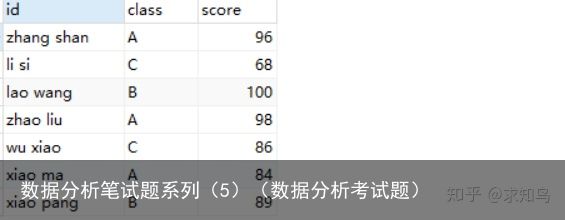
代码如下:(oracle,hive中可以很方便使用row_number()over())
select a.class, a.score * (1 - b.float_part) + a.next_feature1 * (b.float_part-0) as median from (select class,score row_number() over( partition by class order by score asc) as rank, lead(score,1) over(partition by class order by score asc) as next_feature1 from all_scores ) a inner join ( select class, floor((count(score) + 1) / 2) int_part, (count(score)+1) / 2 % 1 as float_part from all_scores group by class ) b on a.rank = b.int_part and a.class=b.class group by a.class没测试,理论上应该正确!Mysql版本:
select a.class, a.score * (1 - b.float_part) + a.next_feature1 * (b.float_part-0) as median from (select if(@class=class,@score:=@score+1,@score:=1) as ran, @class:=class as class, score, lead(score,1) over(partition by class order by score asc) as next_feature1 from all_scores as a,(select @class:=,@score:=0) as c order by class ) a inner join ( select class, floor((count(score) + 1) / 2) int_part, (count(score)+1) / 2 % 1 as float_part from all_scores group by class ) b on a.ran = b.int_part and a.class=b.class group by a.class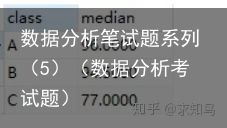
此种写法,有一个瑕疵:当B班只有一个学生的时候,最终结果显示null(实际上B班不可能只有一个学生;当初测试的时候,意外发现这个bug)
各位看官,如果有兴趣可以研究下;为了对Mysql版本写法有更清晰的认识,我将比较陌生的部分单独抽出来进行说明:
select if(@class=class,@score:=@score+1,@score:=1) as ran,--class 是分组键(不能有:),score是排序键 @class:=class as class, score, lead(score,1) over(partition by class order by score asc) as next_feature1 from all_scores as a,(select @class:=,@score:=0) as c --一定要起别名 order by class --必不可少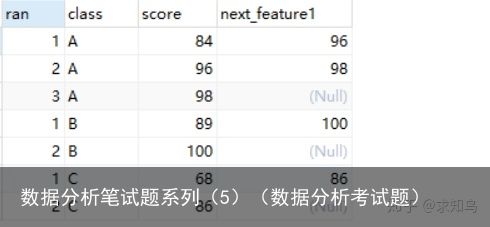
row_number的mysql改写:
有set 与case when的结合;也有本文if的写法,二者效果相同;
两种方法我都尝试了,个人感觉if写法更加容易理解!4、给定如下表结构,请用SQL写出中位数:(四分位数改写?)
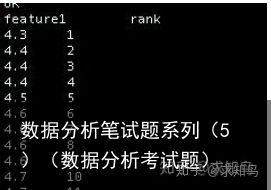
自己练习一下吧(比上述两题都简单啦)
参考答案如下:
求知鸟:数据分析|容易被忽视的统计值22 赞同 · 2 评论文章
5、交易表结构为user_id,id,paid_time,amount
1、写sql查询过去一个月付款用户量(提示 用户量需去重)最高的3天分别是哪几天
2、写sql查询做昨天每个用户最后付款的订单ID及金额
表结构:
create table order_record (id int, user_id int,paid_time datetime,amount bigint); insert into order_record(id,user_id,paid_time,amount) values(1,1028898,2018-01-04 22:32:07.0,9600); insert into order_record(id,user_id,paid_time,amount) values(2,1030621,2018-02-24 23:04:58.0,5400);第一问:
Select date(paid_time),amount From order_record Where month(paid_time)=07 Group by date(paid_time) Order by count(distinct user_id) desc Limit 3第二问:
Select t2.id,t2.amount From ( Select user_id,max(paid_time) as max_date From order_record Where datediff(now(),paid_time)=1 Group by user_id )t1 Inner join ( Select user_id,amount,id,paid_time From order_record Where datediff(now(),paid_time)=1 )t2 On t1.user_id=t2.user_id And t1.max_date=t2.paid_time看的不尽兴,那就关注我的专栏,第一时间知道笔试题状态
数据分析zhuanlan.zhihu.com/c_1101426662830436352
看完,点赞再走@假装看到你!!!








![[众诚云网科技]](/uploads/allimg/20190305/c4b08346cbe8b0efae6b132139c2d72a.png)
 2023-05-28
2023-05-28 浏览次数:次
浏览次数:次 返回列表
返回列表